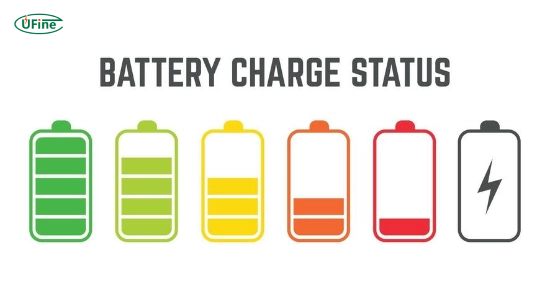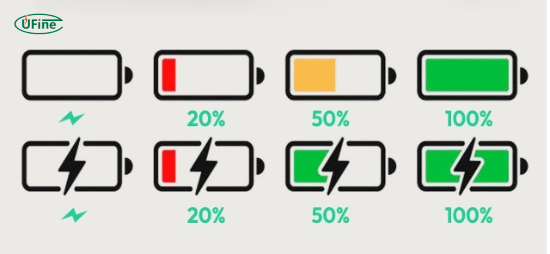
- Part 1. What is battery health, and why does it matter?
- Part 2. How do lithium-ion batteries work?
- Part 3. What percentage of battery health charging should be?
- Part 4. Why is a 100% charge not ideal for battery health?
- Part 5. Is it bad to let your battery drop to 0%?
- Part 6. Charging habits that damage battery health
- Part 7. How to extend battery lifespan with smart charging?
- Part 8. Battery health in electric vehicles (EVs)
- Part 9. The science behind battery degradation
- Part 10. Tips to maximise battery health and performance
- Part 11. FAQs
What percentage of battery health charging should be for maximum lifespan? The ideal battery charging range to ensure maximum lifespan is between 20% and 80%. Keeping your battery within this range helps reduce wear and tear on the internal parts of the battery, slows down chemical aging, and prevents unnecessary heat buildup. Whether you’re using a smartphone, laptop, or EV (electric vehicle), maintaining this charging range can significantly extend the usable life of your battery.
Battery health is crucial to your devices’ overall performance and longevity. In this in-depth guide, we’ll explore how charging percentages affect battery health, the science behind battery degradation, and practical strategies to help you make your batteries last longer.
Part 1. What is battery health, and why does it matter?
Battery health refers to how well your battery holds a charge compared to when it was new. Over time, batteries degrade, which means they lose capacity and can’t have as much power. A battery with 80% health will only offer 80% of its original capacity.
This decline is natural and unavoidable, but how you charge your battery can speed it up or slow it down. That’s why understanding battery health and the best charging practices is essential for anyone who wants to get the most out of their devices.
Part 2. How do lithium-ion batteries work?
Most modern devices use lithium-ion batteries, including smartphones, laptops, tablets, and electric vehicles. These batteries move lithium ions between a positive and a negative electrode. During charging, the ions move in one direction; during use, they flow back.
Each complete charge and discharge is called a cycle. Batteries are designed to handle a certain number of cycles—typically 300 to 1,000 for phones and more for EVs. However, complete cycles (0% to 100%) cause more wear than partial cycles. That’s why charging habits directly impact how long your battery stays healthy.
Part 3. What percentage of battery health charging should be?
So, what percentage of battery health charging should be used for maximum lifespan? The optimal range is 20% to 80%.
Here’s why:
- Charging above 80% increases voltage stress, leading to faster oxidation and chemical aging.
- Dropping below 20% can cause deep discharges, which reduce the battery’s usable cycles.
- Staying between 20% and 80% reduces voltage stress and thermal pressure.
Many battery experts and studies confirm that this range can double your battery’s lifespan compared to charging from 0% to 100% daily.
Part 4. Why is a 100% charge not ideal for battery health?
Charging to 100% isn’t harmful, but regularly keeping your battery at full charge can cause long-term damage. Lithium-ion batteries experience more stress at high voltage levels. This stress leads to chemical reactions inside the battery that permanently reduce its capacity.
Moreover, if your device remains plugged in at 100% for hours (like overnight), it generates heat, further degrading the battery. High state-of-charge combined with heat is one of the worst conditions for battery health.
Part 5. Is it bad to let your battery drop to 0%?
Yes, regularly discharging your battery to 0% is harmful. This is known as a deep discharge, and it can cause the battery to go into a low-voltage state that is difficult to recover.
Low battery levels can lead to:
- Voltage imbalance between battery cells
- Incomplete recharging
- Battery shutdown for safety reasons
To avoid this, try recharging your device from 20% to 30%. This helps maintain stable battery chemistry and extends overall battery life.
Part 6. Charging habits that damage battery health
Let’s look at some everyday charging habits that reduce battery lifespan:
- Charging overnight: While convenient, this keeps your battery at 100% for hours and causes heat buildup.
- Using cheap cables or chargers: Poor quality accessories can deliver unstable power, damaging the battery.
- Charging in hot or cold environments: Batteries work best at room temperature (20°C to 25°C or 68°F to 77°F).
- Fast charging all the time: Generates more heat and shortens lifespan due to increased stress on the battery.
- Leaving your device plugged in for days: This can lead to overcharging and unnecessary voltage stress.
Part 7. How to extend battery lifespan with smart charging?
Many modern devices now come with smart charging features. These tools help you manage charging percentages automatically.
Here are some examples:
- iPhones: Optimised Battery Charging learns your routine and delays charging past 80% until you need it.
- Android phones: Adaptive Charging pauses charging at 80% and resumes later.
- Windows laptops: Battery Care or Dell Power Manager lets you limit charging to 80%.
- MacBooks: Battery Health Management reduces charging to extend lifespan.
If your device doesn’t have these built-in tools, consider using third-party apps or smart plugs with timers to stop charging before it hits full.
Part 8. Battery health in electric vehicles (EVs)
Battery health is even more critical for electric vehicles due to the high replacement cost. Most EV manufacturers recommend charging 80% regularly and only 100% before long trips.
Tesla, for instance, advises daily charging up to 80% and using 100% only when needed. Many EVs have settings that let you set a charging limit, helping you preserve battery health over the long term.
Some EVs use thermal management systems to keep the battery at optimal temperature, reducing heat-related degradation.
Part 9. The science behind battery degradation
Battery degradation happens due to both chemical aging and physical wear. Over time, lithium ions get trapped during the charge/discharge process, reducing the battery’s capacity.
The leading causes of degradation include:
- High voltages (charging close to 100%)
- Low voltages (discharging to 0%)
- High temperatures (above 35°C or 95°F)
- Fast charging
- Excessive charge cycles
By avoiding these stressors, you can significantly slow down battery aging.
Part 10. Tips to maximise battery health and performance
Here are practical tips for daily battery care:
- Keep the charge between 20% and 80%.
- Avoid charging to 100% unless necessary.
- Don’t let your battery drop below 20%.
- Use slow charging instead of fast charging when possible.
- Enable battery optimisation features.
- Avoid extreme temperatures.
- Use certified chargers and cables.
- Unplug the charger once the battery is complete (if not using optimisation tools).
These small habits can double or even triple your battery’s usable life.
Part 11. FAQs
What percentage of battery health charging should be for maximum lifespan?
Keep your battery between 20% and 80% for the best balance of performance and longevity.
Is it okay to charge to 100% sometimes?
Yes, occasionally charging to 100% is fine, especially before a long trip, but avoid doing it daily.
What happens if I always charge to 100%?
Regularly reaching 100% increases battery stress and speeds up degradation.
Is it bad to let my battery die completely?
Yes, deep discharging can damage the battery and reduce its cycle count. Recharge before it hits 0%.
Should I use fast charging every day?
No. Frequent fast charging generates more heat and can shorten battery life. Use only when necessary.
Does heat affect battery health?
Absolutely. Heat is one of the biggest enemies of battery life. Avoid charging in hot environments and remove cases while charging if they cause overheating.
Can I leave my laptop plugged in all the time?
It’s better not to. Use software that limits charging to 80-90% to protect battery health.
Do all devices support charging limits?
Not all, but many modern devices do. Check your settings or download a third-party app if your system allows it.
Related Tags:
More Articles

A Complete Guide to the Best Batteries for Flashlights
Discover the best batteries for flashlights: alkaline, lithium, NiMH & rechargeable options. Tips for performance and maintenance.
Graphene Battery vs Lithium Battery: Which is Better?
Compare graphene battery vs lithium battery in energy density, charging speed, lifespan, cost, and EV applications. Learn which battery leads in 2025.
What is the Difference Between MCA and CCA on Batteries?
Learn the difference between MCA and CCA batteries. Understand what MCA means, what CCA is, and how to choose the right battery for vehicles or marine engines.
Type of Lithium Battery Voltage
Learn lithium ion battery voltage, nominal voltage, and voltage range. Compare Li-ion, LiPo, LiFePO4, and 18650 voltages, charging, and device compatibility.
Gel Battery vs Lead Acid: A Detailed Comparison
Compare gel and lead-acid batteries: lifespan, cost, charging, DoD, safety, and key use cases. Find the right battery for solar, marine, EV, UPS, and daily use.




